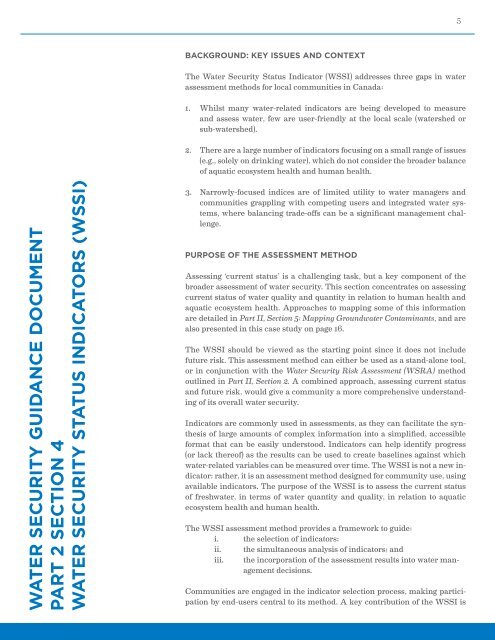Water Security Status Indicators - Program on Water Governance
Water Security Status Indicators - Program on Water Governance
Water Security Status Indicators - Program on Water Governance
You also want an ePaper? Increase the reach of your titles
YUMPU automatically turns print PDFs into web optimized ePapers that Google loves.
WATER SECURITY GUIDANCE DOCUMENT<br />
PART 2 SECTION 4<br />
WATER SECURITY STATUS INDICATORS (WSSI)<br />
BACkGROUND: kEY ISSUES AND CONTExT<br />
The <str<strong>on</strong>g>Water</str<strong>on</strong>g> <str<strong>on</strong>g>Security</str<strong>on</strong>g> <str<strong>on</strong>g>Status</str<strong>on</strong>g> Indicator (WSSI) addresses three gaps in water<br />
assessment methods for local communities in Canada:<br />
1. Whilst many water-related indicators are being developed to measure<br />
and assess water, few are user-friendly at the local scale (watershed or<br />
sub-watershed).<br />
2. There are a large number of indicators focusing <strong>on</strong> a small range of issues<br />
(e.g., solely <strong>on</strong> drinking water), which do not c<strong>on</strong>sider the broader balance<br />
of aquatic ecosystem health and human health.<br />
3. Narrowly-focused indices are of limited utility to water managers and<br />
communities grappling with competing users and integrated water systems,<br />
where balancing trade-offs can be a significant management challenge.<br />
PURPOSE OF ThE ASSESSMENT METhOD<br />
Assessing ‘current status’ is a challenging task, but a key comp<strong>on</strong>ent of the<br />
broader assessment of water security. This secti<strong>on</strong> c<strong>on</strong>centrates <strong>on</strong> assessing<br />
current status of water quality and quantity in relati<strong>on</strong> to human health and<br />
aquatic ecosystem health. Approaches to mapping some of this informati<strong>on</strong><br />
are detailed in Part II, Secti<strong>on</strong> 5: Mapping Groundwater C<strong>on</strong>taminants, and are<br />
also presented in this case study <strong>on</strong> page 16.<br />
The WSSI should be viewed as the starting point since it does not include<br />
future risk. This assessment method can either be used as a stand-al<strong>on</strong>e tool,<br />
or in c<strong>on</strong>juncti<strong>on</strong> with the <str<strong>on</strong>g>Water</str<strong>on</strong>g> <str<strong>on</strong>g>Security</str<strong>on</strong>g> Risk Assessment (WSRA) method<br />
outlined in Part II, Secti<strong>on</strong> 2. A combined approach, assessing current status<br />
and future risk, would give a community a more comprehensive understanding<br />
of its overall water security.<br />
<str<strong>on</strong>g>Indicators</str<strong>on</strong>g> are comm<strong>on</strong>ly used in assessments, as they can facilitate the synthesis<br />
of large amounts of complex informati<strong>on</strong> into a simplified, accessible<br />
format that can be easily understood. <str<strong>on</strong>g>Indicators</str<strong>on</strong>g> can help identify progress<br />
(or lack thereof) as the results can be used to create baselines against which<br />
water-related variables can be measured over time. The WSSI is not a new indicator;<br />
rather, it is an assessment method designed for community use, using<br />
available indicators. The purpose of the WSSI is to assess the current status<br />
of freshwater, in terms of water quantity and quality, in relati<strong>on</strong> to aquatic<br />
ecosystem health and human health.<br />
The WSSI assessment method provides a framework to guide:<br />
i. the selecti<strong>on</strong> of indicators;<br />
ii. the simultaneous analysis of indicators; and<br />
iii. the incorporati<strong>on</strong> of the assessment results into water man-<br />
agement decisi<strong>on</strong>s.<br />
Communities are engaged in the indicator selecti<strong>on</strong> process, making participati<strong>on</strong><br />
by end-users central to its method. A key c<strong>on</strong>tributi<strong>on</strong> of the WSSI is<br />
5







